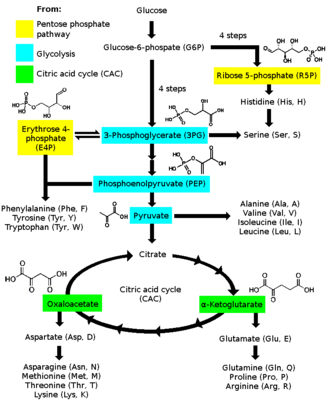Anabolism

Anabolism(/əˈnæbəlɪzəm/) is the set ofmetabolic pathwaysthat constructmacromoleculeslikeDNAorRNAfrom smaller units.[1][2]These reactions requireenergy,known also as anendergonicprocess.[3]Anabolism is the building-up aspect ofmetabolism,whereascatabolismis the breaking-down aspect. Anabolism is usuallysynonymouswithbiosynthesis.
Pathway
[edit]Polymerization,an anabolic pathway used to build macromolecules such as nucleic acids, proteins, and polysaccharides, usescondensation reactionsto join monomers.[4]Macromoleculesare created from smaller molecules using enzymes andcofactors.

Energy source
[edit]Anabolism is powered by catabolism, where large molecules are broken down into smaller parts and then used up incellular respiration.Many anabolic processes are powered by thecleavage of adenosine triphosphate (ATP).[5]Anabolism usually involvesreductionand decreasesentropy,making it unfavorable without energy input.[6]The starting materials, called the precursor molecules, are joined using thechemical energymade available from hydrolyzing ATP, reducing the cofactorsNAD+,NADP+,andFAD,or performing other favorable side reactions.[7]Occasionally it can also be driven byentropywithout energy input, in cases like the formation of thephospholipid bilayerof a cell, where hydrophobic interactions aggregate the molecules.[8]
Cofactors
[edit]The reducing agentsNADH,NADPH,andFADH2,[9]as well as metal ions,[4]act as cofactors at various steps in anabolic pathways. NADH, NADPH, and FADH2act aselectron carriers,while charged metal ions within enzymes stabilize chargedfunctional groupsonsubstrates.
Substrates
[edit]Substrates for anabolism are mostly intermediates taken from catabolic pathways during periods of highenergy chargein the cell.[10]
Functions
[edit]Anabolic processes buildorgansandtissues.These processes produce growth and differentiation of cells and increase in body size, a process that involvessynthesisof complexmolecules.Examples of anabolic processes include the growth and mineralization ofboneand increases inmusclemass.
Anabolic hormones
[edit]Endocrinologistshave traditionally classifiedhormonesas anabolic or catabolic, depending on which part of metabolism they stimulate. The classic anabolic hormones are theanabolic steroids,which stimulate protein synthesis and muscle growth, andinsulin.
Photosynthetic carbohydrate synthesis
[edit]Photosynthetic carbohydrate synthesisin plants and certain bacteria is an anabolic process that producesglucose,cellulose,starch,lipids,andproteinsfrom CO2.[6]It uses the energy produced from the light-driven reactions of photosynthesis, and creates the precursors to these large molecules viacarbon assimilationin thephotosynthetic carbon reduction cycle,a.k.a. the Calvin cycle.[10]

Amino acid biosynthesis
[edit]All amino acids are formed from intermediates in the catabolic processes ofglycolysis,thecitric acid cycle,or thepentose phosphate pathway.From glycolysis,glucose 6-phosphateis a precursor forhistidine;3-phosphoglycerateis a precursor forglycineandcysteine;phosphoenol pyruvate,combined with the3-phosphoglycerate-derivativeerythrose 4-phosphate,formstryptophan,phenylalanine,andtyrosine;andpyruvateis a precursor foralanine,valine,leucine,andisoleucine.From the citric acid cycle,α-ketoglutarateis converted intoglutamateand subsequentlyglutamine,proline,andarginine;andoxaloacetateis converted intoaspartateand subsequentlyasparagine,methionine,threonine,andlysine.[10]
Glycogen storage
[edit]During periods of high blood sugar,glucose 6-phosphatefrom glycolysis is diverted to the glycogen-storing pathway. It is changed toglucose-1-phosphatebyphosphoglucomutaseand then toUDP-glucosebyUTP--glucose-1-phosphate uridylyltransferase.Glycogen synthaseadds this UDP-glucose to a glycogen chain.[10]
Gluconeogenesis
[edit]Glucagonis traditionally a catabolic hormone, but also stimulates the anabolic process ofgluconeogenesisby the liver, and to a lesser extent the kidney cortex and intestines, during starvation to preventlow blood sugar.[9]It is the process of converting pyruvate into glucose. Pyruvate can come from the breakdown of glucose,lactate,amino acids, orglycerol.[11]The gluconeogenesis pathway has many reversible enzymatic processes in common with glycolysis, but it is not the process of glycolysis in reverse. It uses different irreversible enzymes to ensure the overall pathway runs in one direction only.[11]
Regulation
[edit]Anabolism operates with separate enzymes from catalysis, which undergo irreversible steps at some point in their pathways. This allows the cell to regulate the rate of production and prevent an infinite loop, also known as afutile cycle,from forming with catabolism.[10]
The balance between anabolism and catabolism is sensitive toADPand ATP, otherwise known as the energy charge of the cell. High amounts of ATP cause cells to favor the anabolic pathway and slow catabolic activity, while excess ADP slows anabolism and favors catabolism.[10]These pathways are also regulated bycircadian rhythms,with processes such asglycolysisfluctuating to match an animal's normal periods of activity throughout the day.[12]
Etymology
[edit]The wordanabolismis fromNeo-Latin,with roots fromGreek:ἀνά,"upward" andβάλλειν,"to throw".
References
[edit]- ^Shimizu, Kazuyuki (2013). "Main metabolism".Bacterial Cellular Metabolic Systems.Elsevier. p. 1–54.doi:10.1533/9781908818201.1.ISBN978-1-907568-01-5.
- ^de Bolster MW (1997)."Glossary of Terms Used in Bioinorganic Chemistry: Anabolism".International Union of Pure and Applied Chemistry. Archived fromthe originalon 30 October 2007.Retrieved2007-10-30.
- ^Rye C, Wise R, Jurukovski V, Choi J, Avissar Y (2013).Biology.Rice University, Houston Texas: OpenStax.ISBN978-1-938168-09-3.
- ^abAlberts B, Johnson A, Julian L, Raff M, Roberts K, Walter P (2002).Molecular Biology of the Cell(5th ed.). CRC Press.ISBN978-0-8153-3218-3.Archived fromthe originalon 27 September 2017.Retrieved2018-11-01.Alt URL
- ^Nicholls DG, Ferguson SJ (2002).Bioenergetics(3rd ed.). Academic Press.ISBN978-0-12-518121-1.
- ^abAhern K, Rajagopal I (2013).Biochemistry Free and Easy(PDF)(2nd ed.). Oregon State University.
- ^Voet D, Voet JG, Pratt CW (2013).Fundamentals of biochemistry: life at the molecular level(Fourth ed.). Hoboken, NJ: Wiley.ISBN978-0-470-54784-7.OCLC738349533.
- ^Hanin I, Pepeu G (2013-11-11).Phospholipids: biochemical, pharmaceutical, and analytical considerations.New York.ISBN978-1-4757-1364-0.OCLC885405600.
{{cite book}}:CS1 maint: location missing publisher (link) - ^abJakubowski H (2002)."An Overview of Metabolic Pathways - Anabolism".Biochemistry Online.College of St. Benedict, St. John's University: LibreTexts.
- ^abcdefNelson DL, Lehninger AL, Cox MM (2013).Principles of Biochemistry.New York: W.H. Freeman.ISBN978-1-4292-3414-6.
- ^abBerg JM, Tymoczko JL, Stryer L (2002).Biochemistry(5th ed.). New York: W.H. Freeman.ISBN978-0-7167-3051-4.OCLC48055706.
- ^Ramsey KM, Marcheva B, Kohsaka A, Bass J (2007). "The clockwork of metabolism".Annual Review of Nutrition.27:219–40.doi:10.1146/annurev.nutr.27.061406.093546.PMID17430084.
